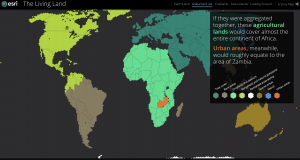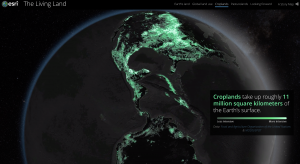ArcGIS Online has a public database of professional Storymaps on a variety of environmental and global issues. You can explore one series of storymaps titled “The Living Land,” on the distribution of human activities on the surface of the Earth. Chapter Two of this resource takes a special look at the distribution and impact of agriculture, animal husbandry, and farm land on the Earth.
 This storymap takes the user through the distribution as percentage of land, by regions of the world, density, and areas of highest production. It also describes how crops change the land and how each of humanities major crops (corn soy, rice, etc.) and major livestock (cows, chickens, goats, etc.) are grown around the world using aerial imagery. This storymap relies heavily on maps, as it should, to demonstrate these environmental and social issues. This includes simplified dot representation of the predominant crop in one area, to spinning globes with particular crops highlighted. This web application is a useful tool to demonstrate spatial distributions in a way that is easy to understand. It takes you through a whole system of human behavior around the world and its impacts on land (impact on pedosphere) depending on different practices.
This storymap takes the user through the distribution as percentage of land, by regions of the world, density, and areas of highest production. It also describes how crops change the land and how each of humanities major crops (corn soy, rice, etc.) and major livestock (cows, chickens, goats, etc.) are grown around the world using aerial imagery. This storymap relies heavily on maps, as it should, to demonstrate these environmental and social issues. This includes simplified dot representation of the predominant crop in one area, to spinning globes with particular crops highlighted. This web application is a useful tool to demonstrate spatial distributions in a way that is easy to understand. It takes you through a whole system of human behavior around the world and its impacts on land (impact on pedosphere) depending on different practices.

I love how this resource combines GIS with stunning imagery and graphics to capture how humans use and impact the land around us. This story map emphasizes just how little land is devoted to urbanization and how large our agricultural footprint is. When we think about land-use change it is often in terms of urbanization, but we also need to think critically about our agricultural production methods.
I like that this uses storymap to explain environmental and social issues. It is also interesting to compare human activities around the world.
This is a really interesting find, thanks for sharing! I think this tool could be useful not only for geographers but also for people in the social sciences who want to learn about distribution of resources, particularly agriculture. This data could help wide scale efforts to feed impoverished countries.